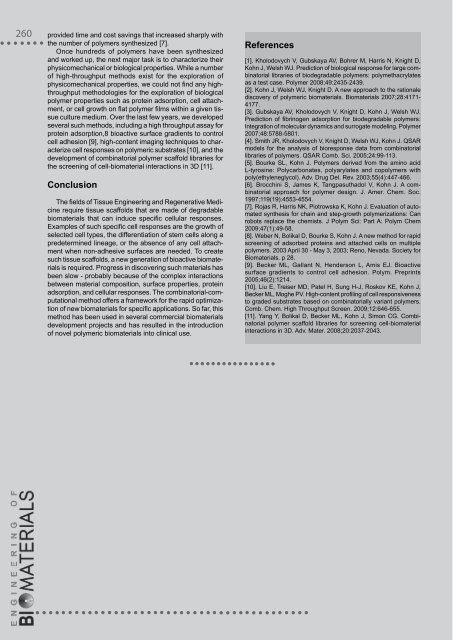89-91 - Polskie Stowarzyszenie Biomateriałów
89-91 - Polskie Stowarzyszenie Biomateriałów
89-91 - Polskie Stowarzyszenie Biomateriałów
Create successful ePaper yourself
Turn your PDF publications into a flip-book with our unique Google optimized e-Paper software.
260 provided time and cost savings that increased sharply with<br />
the number of polymers synthesized [7].<br />
Once hundreds of polymers have been synthesized<br />
and worked up, the next major task is to characterize their<br />
physicomechanical or biological properties. While a number<br />
of high-throughput methods exist for the exploration of<br />
physicomechanical properties, we could not find any highthroughput<br />
methodologies for the exploration of biological<br />
polymer properties such as protein adsorption, cell attachment,<br />
or cell growth on flat polymer films within a given tissue<br />
culture medium. Over the last few years, we developed<br />
several such methods, including a high throughput assay for<br />
protein adsorption,8 bioactive surface gradients to control<br />
cell adhesion [9], high-content imaging techniques to characterize<br />
cell responses on polymeric substrates [10], and the<br />
development of combinatorial polymer scaffold libraries for<br />
the screening of cell-biomaterial interactions in 3D [11].<br />
conclusion<br />
The fields of Tissue Engineering and Regenerative Medicine<br />
require tissue scaffolds that are made of degradable<br />
biomaterials that can induce specific cellular responses.<br />
Examples of such specific cell responses are the growth of<br />
selected cell types, the differentiation of stem cells along a<br />
predetermined lineage, or the absence of any cell attachment<br />
when non-adhesive surfaces are needed. To create<br />
such tissue scaffolds, a new generation of bioactive biomaterials<br />
is required. Progress in discovering such materials has<br />
been slow - probably because of the complex interactions<br />
between material composition, surface properties, protein<br />
adsorption, and cellular responses. The combinatorial-computational<br />
method offers a framework for the rapid optimization<br />
of new biomaterials for specific applications. So far, this<br />
method has been used in several commercial biomaterials<br />
development projects and has resulted in the introduction<br />
of novel polymeric biomaterials into clinical use.<br />
references<br />
[1]. kholodovych V, Gubskaya AV, Bohrer M, Harris N, knight D,<br />
kohn J, Welsh WJ. Prediction of biological response for large combinatorial<br />
libraries of biodegradable polymers: polymethacrylates<br />
as a test case. Polymer 2008;49:2435-2439.<br />
[2]. kohn J, Welsh WJ, knight D. A new approach to the rationale<br />
discovery of polymeric biomaterials. Biomaterials 2007;28:4171-<br />
4177.<br />
[3]. Gubskaya AV, kholodovych V, knight D, kohn J, Welsh WJ.<br />
Prediction of fibrinogen adsorption for biodegradable polymers:<br />
Integration of molecular dynamics and surrogate modeling. Polymer<br />
2007;48:5788-5801.<br />
[4]. Smith JR, kholodovych V, knight D, Welsh WJ, kohn J. QSAR<br />
models for the analysis of bioresponse data from combinatorial<br />
libraries of polymers. QSAR Comb. Sci. 2005;24:99-113.<br />
[5]. Bourke SL, kohn J. Polymers derived from the amino acid<br />
L-tyrosine: Polycarbonates, polyarylates and copolymers with<br />
poly(ethyleneglycol). Adv. Drug Del. Rev. 2003;55(4):447-466.<br />
[6]. Brocchini S, James k, Tangpasuthadol V, kohn J. A combinatorial<br />
approach for polymer design. J. Amer. Chem. Soc.<br />
1997;119(19):4553-4554.<br />
[7]. Rojas R, Harris Nk, Piotrowska k, kohn J. Evaluation of automated<br />
synthesis for chain and step-growth polymerizations: Can<br />
robots replace the chemists. J Polym Sci: Part A: Polym Chem<br />
2009;47(1):49-58.<br />
[8]. Weber N, Bolikal D, Bourke S, kohn J. A new method for rapid<br />
screening of adsorbed proteins and attached cells on multiple<br />
polymers. 2003 April 30 - May 3, 2003; Reno, Nevada. Society for<br />
Biomaterials. p 28.<br />
[9]. Becker ML, Gallant N, Henderson L, Amis EJ. Bioactive<br />
surface gradients to control cell adhesion. Polym. Preprints<br />
2005;46(2):1214.<br />
[10]. Liu E, Treiser MD, Patel H, Sung H-J, Roskov kE, kohn J,<br />
Becker ML, Moghe PV. High-content profiling of cell responsiveness<br />
to graded substrates based on combinatorially variant polymers.<br />
Comb. Chem. High Throughput Screen. 2009;12:646-655.<br />
[11]. yang y, Bolikal D, Becker ML, kohn J, Simon CG. Combinatorial<br />
polymer scaffold libraries for screening cell-biomaterial<br />
interactions in 3D. Adv. Mater. 2008;20:2037-2043.













